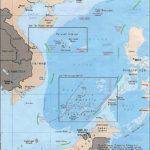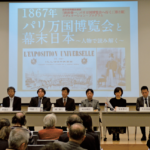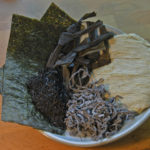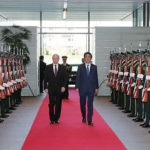Shinto’s power reveals itself as the core of a local community’s resilience when struck by a disaster or an epidemic, writes Funabashi Haruo.
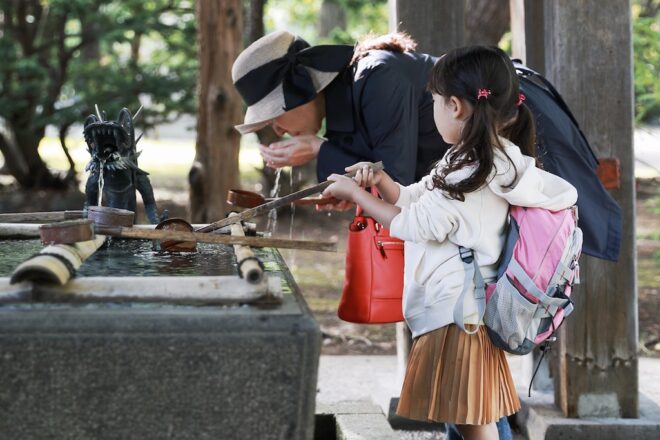
A child and a woman purify themselves at a chozubachi water basin before entering a shrine (2019 photo). MIKI Yoshihito, CC BY 2.0, via Wikipedia
The cities, towns and villages along the Pacific coast from northern Kanto to Tohoku suffered devastating blows during the Great East Japan Earthquake in 2011. During the earthquake, shrines located in each area barely escaped the disaster and became emergency shelters for many victims. If you plot out the location of these shrines, you will see that they avoided flooded areas quite well. This is said to be because they were located away from these areas, as memories of the Jogan Tsunami (867) still lingered. This is an unexpected example of the wisdom of predecessors being put to use.
How about the coronavirus pandemic today?
Japanese people practice gargling and hand washing, the most important actions to prevent infection, without any resistance, and they continue to refine these actions. This is because these actions are customs that have been retained by Japanese people since ancient times. If you go to a shrine, there is something called a chozubachi, and there is water normally flowing here. Visitors to the shrine scoop up the water with a ladle at the chozubachi, wash their hands and rinse out their mouths. This is not to prevent the spread of COVID-19. Indeed, there seem to be many shrines recently that have removed the ladles as there may be a chance of viral contact infection. Rather, these actions are performed to cleanse the mind and body.
In the Shinto religion, there is the concept of kegare. Loosely, the term refers to a kind of impurity. It does not refer to something being dirty, but rather to the state of having exhausted natural human energy. This is detested as it is related to death and to the act of committing sins. The idea is that washing the body with pure water is effective in doing away with this kegare. This action is called misogi. The term refers to a kind of purification.
It seems to me that Japan has been a rainy country since ancient times, with mountains covered in greenery, and is a land where pure waters well up from the forests. Japanese people of old thought that their souls would be cleansed the same way as when they washed and cleansed their bodies with this water. This was not always something that they were consciously aware of. However, when in front of a clear stream, many Japanese people cannot help but think that the water will cleanse their souls. There is no mistaking the fact that this feeling is at the root of a Japanese person’s idea of sanitation. This can perhaps also be said to be part of the wisdom of our predecessors. If we gave this a name, it would be “the power of the shrine.”
The Shinto religion, which these shrines embody, has come to be seen as a primitive, lowly religion from a Western European religious viewpoint. That is to say that Shinto didn’t have a charismatic founder, it didn’t establish any extensive doctrine or scripture, and it doesn’t have any aggressive groups of clergy to spread and maintain the faith. So you could wonder if it was even a religion at all.
However, this is not to say that Shinto is without power. In some cases, it may display a power that is more profound than that of a half-hearted religious person.
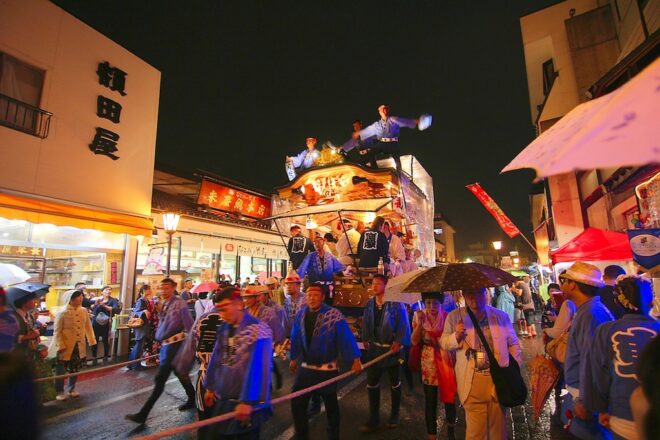
Pulling together: Residents of Narita City pull a dashi float through the streets during the annual Narita City Gion Festival (2014 photo). sodai gomi, CC BY 2.0, via flickr
This is Shinto’s power as the core of a local community’s resilience that appears when the community suffers from a disaster or an epidemic. What we saw during the Great East Japan Earthquake was the depth of the bonds of the people in affected areas, who worked together to care for other locals while suffering immense damage themselves. Even in the current disastrous condition with the COVID-19 pandemic, these kinds of bonds are alive and well in areas that have controlled infected persons to a certain degree. The people in these areas mutually watch the health conditions of those they are close to every day and are in a position to take necessary actions quickly if anything changes.
Many of these bonds are from being parishioners of the same shrine, pulling dashi floats together during festivals, or performing with musical instruments. These people live in a world of mutual dependence and aid. There may be people who criticize this from a “modern” viewpoint as not being independent or that it hasn’t taken even a single step away from being a village society. But mutual dependence and aid are basic aspects of human life, and they are the most sought after in the harshest of times. This is the very reason why the “power of the shrine” ought to be reevaluated today.
FUNABASHI Haruo is a historian and CEO of the Sirius Institute Inc.
Note: This article first appeared in the Sept./Oct. 2020 issue of the Japan Journal.



